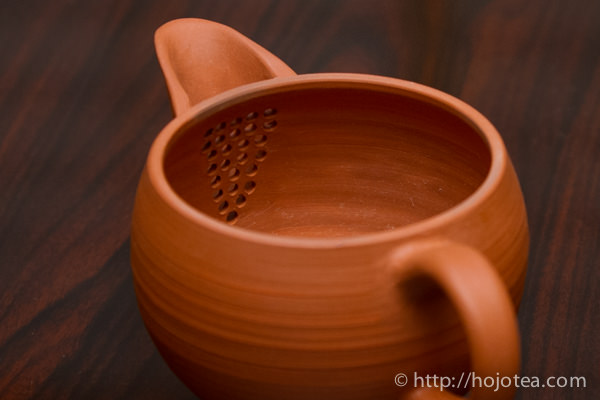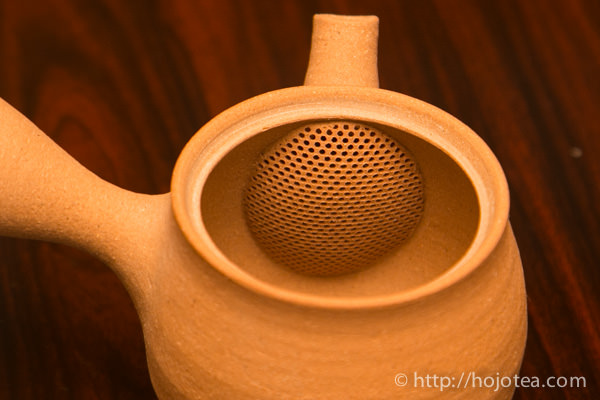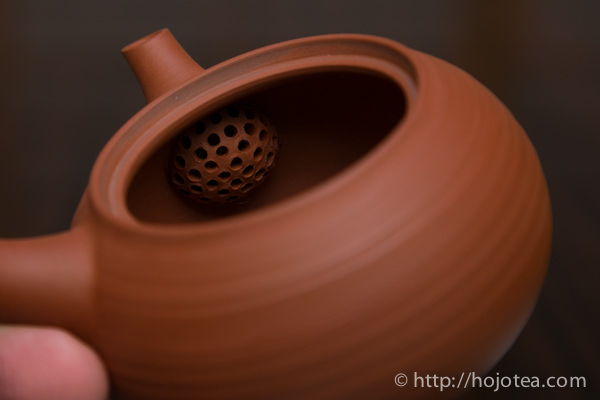- HOME >
- Teapot and Tea Equipment
The advantage and disadvantage with different type of filter on teapot
- [2014.02.10] Posted By Akira Hojo

I would like to share some points of teapot selecting based on the type of filter. Generally, there are 4 types of filter commonly used as follow.
- Direct hole: The single or multi-number holes directly made on the body
- Sasame/Seramesh: Originated by Tokoname potters. Tiny holes were made on one piece of clay, and then attached to the body.
- Ball or Bulbous shape filter with multi-holes
- Stainless steel mesh filter
Direct hole filter
The filter holes were made directly on the inner body of the teapot. As the filter is part of the teapot, the artists have to maintain very high concentration while shaping the filter holes. Furthermore, if any mistake is made to the filter hole, the entire teapot will be ruined. Mainly, Japanese and China teapots (Yixing) of a much more sophisticated molding uses this filter design due to its efficacy in drainage. With this design, we are able to completely drain the tea to its last drop. On the contrary, a tea that consists of finer leaves tends to get stuck onto the filter. For instance, this filter is not practical for brewing the Fukamushi sencha (deep steamed sencha), although it is usable for most sencha. Among this design of filters, I would prefer the model that comes with more number of holes.
Sasame/Seramesh filter
Originally, this filter design was developed in Tokoname City. This filter is of a flat and wide shape together with numerous tiny holes on its surface. Despite the filter is made of clay, it is practical to brew tea of mostly tiny leaves like the Fukamushi sencha. Contrarily, this design tends to retain some water as it has less drainage efficiency compared to other types of filter.
Ball/Bulbous shape filter
The ball shape filter has the features of both the direct hole filter and seramesh/sasame, but it’s drainage attribute is better than the sasame filter and it’s chance of leaves chocking in the filter (direct hole design) is reduced. However, if you brew the Fukamushi sencha with leaves that are too dusty, it may sometimes get chocked.
Stainless steel mesh filter
The filter is made of a stainless steel mesh that varies in shape. Regardless of the shape, however, this filter performs excellently as any tea is suitable. The water flow is fast enough even for tea with lots of tiny leaves. Though, quite a number of people may think that the stainless steel mesh spoils the taste of tea, nonetheless, the water kettle, water treatment system, tap and many other materials which are made of stainless steel have already contributed to the effect on water even before getting in contact with the teapot. Based on my tasting experience, there is no negative impact with the stainless steel tea strainer. Usually, the stainless steel strainer is used for non-handmade teapots.
As a conclusion, it is important to understand the advantages and disadvantages of each design of the filter. You may also select a different type of filter based on the type of tea you intend to brew.
Related Articles
How to get the latest update on HOJO?
1. Follow Twitter, 2. Click "Like" on Facebook, and 3. Subscribe in newsletter. You can have the latest tea news from HOJO.
 Subscribe the Newsletter to enjoy the privileges
Subscribe the Newsletter to enjoy the privileges- You may receive a free sample upon purchase, or you may have the priority to purchase special products. So please remember to subscribe our newsletter as well as the social network.
- Myanmar White Tea Bud 2013 from Guo Gan, Myanmar
- We have released a raw Pu-erh tea, 緬甸白芽茶 2013 (Myanmar White Tea Bud 2013), produced by ethnic minorities in t …
- Yong De Wild White Tea 2025 Loose Leaf Limited Release
- We have released Yong De Wild White Tea Loose 2025. For the 2025 harvest, only the loose-leaf type was …
NEW ARTICLES
 Myanmar White Tea Bud 2013 from Guo Gan, Myanmar
Myanmar White Tea Bud 2013 from Guo Gan, Myanmar- We have released a raw Pu-erh tea, 緬甸白芽茶 2013 (Myanmar White Tea Bud 2013), produced by ethnic minorities in t …
 Yong De Wild White Tea 2025 Loose Leaf Limited Release
Yong De Wild White Tea 2025 Loose Leaf Limited Release- We have released Yong De Wild White Tea Loose 2025. For the 2025 harvest, only the loose-leaf type was …
 Experience the True Freshness of Raw Pu-erh : Tang Jia 2025 Loose Leaf Release
Experience the True Freshness of Raw Pu-erh : Tang Jia 2025 Loose Leaf Release- We have released Tang Jia Raw Pu-erh Tea 唐家古樹生茶 2025 Loose Leaf. Among HOJO’s raw pu-erh teas, Tang Jia Raw Pu …
 Yunnan Chun Jian Green Tea from High Mountain Gardens
Yunnan Chun Jian Green Tea from High Mountain Gardens- Yunnan Chun Jian Green Tea is now available. This tea is made from naturally grown leaves harvested from high …
 Limited Loose Leaf Release of 2025 Da Xue Shan Wild Raw Pu-erh Tea
Limited Loose Leaf Release of 2025 Da Xue Shan Wild Raw Pu-erh Tea- We have released the 2025 loose-leaf version of Da Xue Shan Wild Raw Pu-erh Tea. This tea comes from wild tea …
 Discover a New Way to Enjoy Tea: Cooking Rice with Tea
Discover a New Way to Enjoy Tea: Cooking Rice with Tea- Cooking rice with tea is a simple idea, but it brings surprisingly satisfying results. The tea’s flavour seeps …
 2025 Da Xue Shan Wild White Tea Now Available from Yunnan
2025 Da Xue Shan Wild White Tea Now Available from Yunnan- The 2025 harvest of Da Xue Shan Wild White Tea is now available. Crafted from truly wild Camellia taliensis tr …
 Fresh 2025 Yunnan White Tea – Select Your Favourite Lot Before Blending
Fresh 2025 Yunnan White Tea – Select Your Favourite Lot Before Blending- Freshly crafted in Yunnan and just arrived in KL, our new 2025 white tea is now available at our Gardens Mall …
 2024 Dong Shan Raw Pu-erh Tea – Crafted with the Producer for Desired Quality
2024 Dong Shan Raw Pu-erh Tea – Crafted with the Producer for Desired Quality- We have released the 2024 cake of Dong Shan Raw Pu-erh Tea. Earlier, we offered the loose-leaf version from th …
 Development of Firewood Roasted Hojicha Using Naturally Grown Tea from Yunnan
Development of Firewood Roasted Hojicha Using Naturally Grown Tea from Yunnan- We are currently staying in Yunnan Province for tea production. As the season nears its end, tea trees with pa …
Category
- New Arrival at HOJO Online Shop
- Featured Articles
- Newsletter
- Types of Tea
- Origin of Tea
- Teapot and Tea Equipment
- Tea Column
- How to enjoy tea
- Tea Processing
- How to choose quality tea
- Tea constituents and functional effect
- Safety of Tea
- Foods
- Tea Business Operation
- Hobby and Outdoor Activity
- Ranking of Tea
- Video
- FAQ
- Media Release
Profile

- AKIRA HOJO
- I invite you to experience my tea selections.I was born in Nagano, Japan. In university, I studied agricultural chemistry, and I have the master degree in food science. I worked in Japanese food industry for 10 years. I involved in R&D, QC and QA. As a factory manager, I implemented ISO9000 series and managed the factory.
- The Art of Tea Magazine
- We posted the article on “The Art of Tea Magazine No.9, the magazine is published in Taiwan. We featured …
- New Straits Times
- The Malaysian National Newspaper, New Straits Times featured HOJO Tea on 17-Oct-2007.
Shop Info

Address:Lot No. T-215, 3rd Floor, The Gardens Mall, Mid Valley City, Lingkaran Syed Putra, 59200 Kuala Lumpur
Tel: +603-2287-4537
Business Hour: 10am to 10pm


















